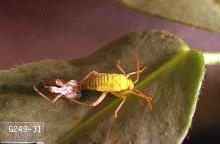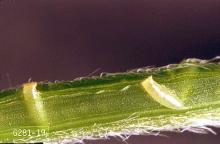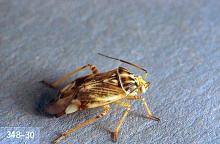Lygus spp.
Pest description, crop damage and life history
See:
Common Pests of Vegetable Crops
Pest monitoring Use sweep nets to sample for lygus bugs. In the Pacific Northwest, a suggested treatment threshold is one-half adult or one-half for fourth or fifth instar per sweep..
Management-biological control
Generalist predators, such as lacewings and damsel bugs, may prey on lygus bug nymphs. Conserve populations of these biological control agents by minimizing applications of broad-spectrum insecticides.
Management-cultural control
Lygus are likely to move when other food sources become unsuitable. Common weeds that are good hosts of lygus bugs include pigweed and wild radish.
Mowed alfalfa fields nearby are commonly a source of large numbers of lygus bug adults. There are a number of practices to reduce or control the movement of adults from alfalfa into nearby bean fields. These techniques leave uncut, tall alfalfa (which is attractive to lygus bug adults) within or near the cut area.
Management-chemical control: HOME USE
Follow information given on the label about the timing and cutoff date for the particular vegetable you are spraying.
- azadirachtin (neem oil)-Some formulations are OMRI-listed for organic use.
- bifenthrin (often as a mix with zeta-cypermethrin)
- carbaryl
- esfenvalerate
- gamma-cyhalothrin
- malathion
- plant essential oils (garlic, rosemary, etc.)-Some have demonstrated efficacy. Some formulations are OMRI-listed for organic use.
- pyrethrins (often combined with other ingredients)-Some formulations are OMRI-listed for organic use.
- zeta-cypermethrin
Management-chemical control: COMMERCIAL USE
- bifenthrin (Sniper) at 0.08 to 0.1 lb ai/A. PHI 3 days. REI 12 hr. Do not exceed 0.2 lb ai/A per year.
- Chenopodium ambrosioides (Requiem Prime) at 2 to 4 quarts product per acre. PHI 0 day. REI 4 hr.
- chlorantraniliprole/lambda-cyhalothrin (Besiege) at 0.06 to 0.1 lb ai/A. PHI 7 days. REI 24 hr. Retreatment interval 5 days. Do not exceed a total of 31.0 fl oz of Besiege or 0.12 lb ai of lambda-cyhalothrin or 0.2 lb ai of chlorantraniliprole per acre per growing season. Do not graze livestock or harvest vines for forage or hay.
- dimethoate (Dimethoate 4E) at 0.5 lb ai/A. PHI 0 days. REI 48 hr. Retreatment interval 14 days. Do not exceed 1.0 lb/A per year. Do not feed treated vines.
- flonicamid (Beleaf 50SG) at 0.089 lb ai/A. PHI 7 days. REI 12 hr. Limit 2 treatments. Do not exceed 0.089 lb/A per year.
- Isaria fumosorosea (PFR-97 20%WDG) at 1 to 2 lb product per acre. PHI 0 days. REI 4 hr. Repeat every 3 to 10 days as needed. OMRI-listed for organic use.
- lambda-cyhalothrin (Warrior II) at 0.02 to 0.03 lb ai/A. PHI 7 days. REI 24 hr. Retreatment interval 5 days. Do not exceed 0.12 lb ai/A per year. Do not graze livestock in treated areas or harvest vines for forage or hay.
- methomyl (Lannate SP) at 0.45 to 0.9 lb ai/A. PHI 1 to 3 days for beans, 3 days for feeding vines, 7 days for hay. REI 48 hr. Do not exceed 4.5 lb ai/A per year.
- naled (Dibrom8) at 0.94 lb ai/A. PHI 1 day. REI 48 hr. Retreatment interval 7 days. Do not exceed 5 treatments per season.
- novaluron (Rimon 0.83EC) at 0.078 lb ai/A. PHI 1 day. REI 12 hr. Retreatment interval 7 days. Wait until lygus appear. Do not exceed 0.23 lb ai/A per season.
- phorate (Thimet 20G)-Do not exceed 1.5 lb ai/A. PHI 60 days. REI 48 to 72 hr. At planting time only. Do not graze or feed to livestock. Toxic to fish and wildlife.
- sulfoxaflor (Transform WG) at 0.047 to 0.071 lb ai/A. PHI 7 days. REI 24 hr. Retreatment interval 14 days. Do not exceed two consecutive applications per crop. Do not exceed 0.266 lb ai/A per year.



